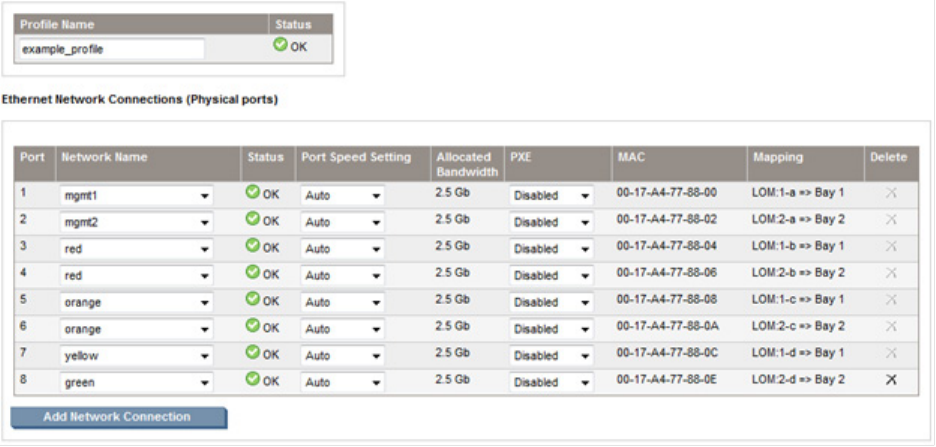Manual
Table Of Contents
- HP Virtual Connect for c-Class BladeSystemVersion 3.01User Guide
- Notice
- Contents
- Introduction
- Overview
- HP Virtual Connect Manager
- Domain management
- Domain overview
- Firmware updates
- Domain Settings (Domain Configuration) screen
- Domain Settings (Domain IP Address) screen
- Domain Settings (Domain Enclosures) screen
- Domain Settings (Backup/Restore) screen
- Domain Settings (Local Users) screen
- Directory Settings (Directory Server) screen
- Directory Settings (Directory Groups) screen
- Directory Settings (Directory Certificate) screen
- Test LDAP authentication
- SNMP overview
- System Log screen
- System Log Configuration
- Network management
- Networks overview
- Define Ethernet Network screen
- Edit Ethernet Network screen
- Ethernet Networks (External Connections) screen
- Ethernet Networks (Server Connections) screen
- Ethernet Settings (MAC Addresses) screen
- Ethernet Settings (Port Monitoring) screen
- Ethernet Settings (Advanced Settings) screen
- Stacking Links screen
- Shared uplink sets and VLAN tagging
- Define Shared Uplink Set screen
- Shared Uplink Sets (External Connections) screen
- Shared Uplink Sets (Associated Networks) screen
- Storage management
- Server management
- Certificate Administration
- Hardware information screens
- Enclosure Information screen
- Enclosure Status screen
- Interconnect Bays Status and Summary screen
- Causes for INCOMPATIBLE status
- Interconnect Bay Summary screen (Ethernet module)
- Interconnect Bay Summary screen (VC-FC Module)
- Module removal and replacement
- Interconnect Bay Overall Status icon definitions
- Interconnect Bay OA Reported Status icon definitions
- Interconnect Bay VC Status icon definitions
- Interconnect Bay OA Communication Status icon definitions
- Server Bays Summary screen
- Server Bay Status screen
- Acronyms and abbreviations
- Glossary
- Index

Server management 96
Flex-10 configuration
Network administrator
For each Virtual Connect network, the network administrator can set a "Preferred" and "Maximum" speed
for FlexNICs that connect to that network. FlexNICs cannot connect to a network at a speed higher than
the maximum speed set by the network administrator for that network. The "preferred" speed setting is the
speed recommended by the network administrator for any FlexNIC that attaches to that network. The
server administrator can choose to follow or disregard this recommendation.
The network administrator can change these two settings by clicking the Advanced button on the
create/edit network screen. For additional information, see "Multiple Networks Link Speed Settings (on
page 72)."
Server administrator
The server administrator can configure a requested bandwidth for every connection in a server profile.
Virtual Connect can control the link speed of FlexNICs, but cannot control the link speed of traditional
NICs.
The server administrator has three choices for Requested Bandwidth for each connection:
1. Preferred. Choosing "Preferred" sets the requested bandwidth equal to the bandwidth recommended
by the network administrator's "Preferred" speed setting for that network. If the administrator has not
configured a preferred bandwidth for the network, this setting is treated the same as "Auto".
2. Custom. Choosing "Custom" enables the user to specify a number between 100Mb and 10Gb (in
increments of 100Mb) for requested bandwidth.
3. Auto. Choosing "Auto" evenly distributes the available bandwidth between all connections assigned
to "auto".
For additional information, see "Bandwidth assignment (on page 98)."
Although the Port Speed Setting is available for all network connections in a profile, Virtual Connect can
only control link speed for Flex-10 NICs when they are connected to an HP Virtual Connect Flex-10
Module. Virtual Connect cannot control the link speed of traditional NICs. Allowing specification of port
speed regardless of the underlying NIC allows the profile to configure the connection automatically when
moved to or from Flex-10 enabled servers and NICs.










